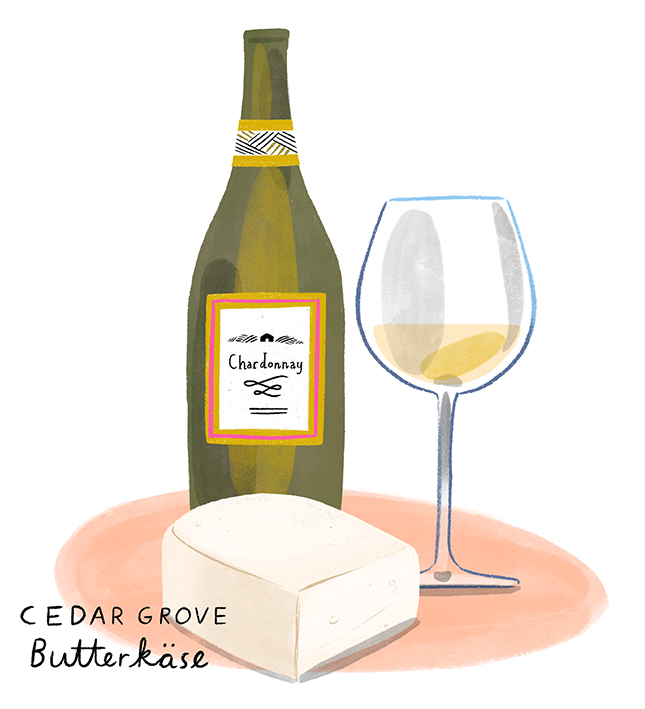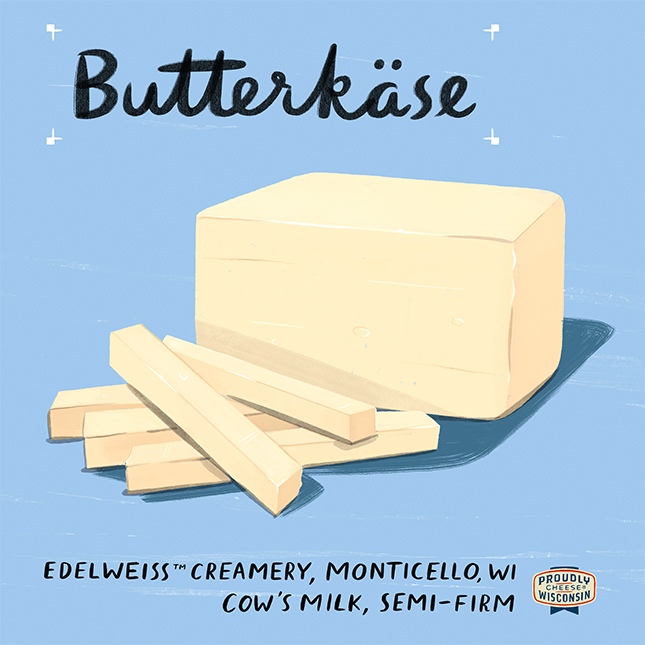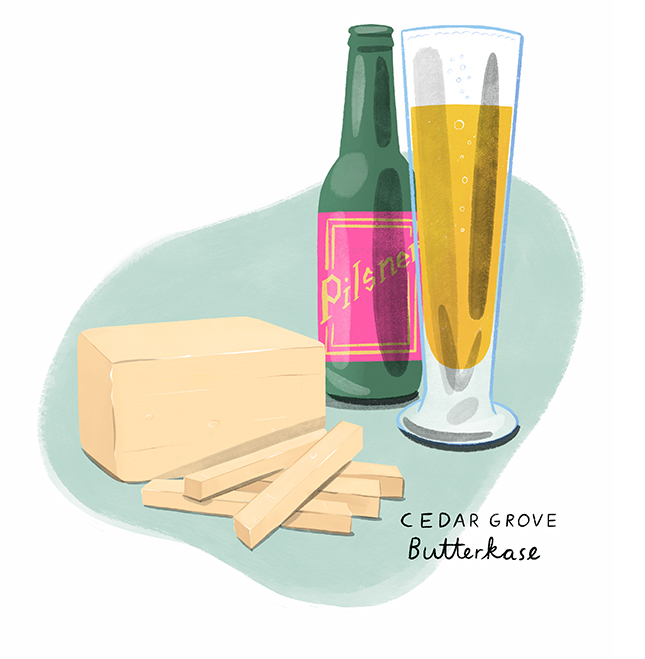Perhaps we’ll
start things off with a quick language lesson, shall we? Say it with us: “
booter-keh-zuh”. Still not sure if you’re getting it right? Try
this helpful pronunciation lesson
if you really want to nail it.
In German, the word “butterkäse” roughly translates to “butter
cheese”. As a cheese-loving group of folks living in the State of Cheese, we
can tell you firsthand that butter and cheese are pretty much the ultimate
dairy duo. But that’s where the magic of butterkäse really shines — it doesn’t
have any butter in it.
Intrigued? We thought you might be.
Cheese history: The story behind butterkäse

To get to the bottom of butterkäse, we’ve got to go back to
when it all began. Which honestly, wasn’t all that long ago. In 1906, an
Italian cheese called Bel Paese hit the streets. Its
soft, buttery qualities were quickly becoming a favorite across Europe, and
creameries everywhere wanted to create something similar.
However, the Italians
were very clever about protecting their original products, and upon realizing
the popularity of Bel Paese, they swiftly trademarked the name. This meant that other
creameries would have to come up with their own versions.
The Staatliche Molkerei Weihenstephan dairy
company threw their hat into the butter cheese game in 1928. They produced the first German
version of the popular Italian formaggio, marketing it as Butterkäse. It
appealed to the general public, and especially to children who, like most young
kids, weren’t into the “stinky” cheeses German cheesemakers were known for.
Butterkäse was mild in flavor, inexpensive to make (thanks
to modern factory production and this cheese's short aging process), and easy to use on
sandwiches and other quick-to-prepare foods. Its delicate character also earned
it the nickname damenkäse, meaning "ladies cheese".
And there you have it — a käse star was born!
Over the decades, butterkäse has actually surpassed Bel
Paese in terms of popularity, offering a richer, more buttery flavor than its
predecessor.
Today, the butter cheese tradition continues, but in Wisconsin, it’s
taken a distinctively artisan turn from its mass-produced ancestors. Wisconsin Butterkäse is reminiscent of a young gouda or muenster with plenty of Old World heritage blended with
decades of innovation.
All about butterkäse

How is butterkäse made?
Like most cheeses, butterkäse is made from milk,
cultures, rennet, and salt. The main difference is that
for this particular cheese, the milk is heated to a high temperature before the rennet is added. It
then gently acidifies and coagulates with rennet, leaving it with a higher moisture
content and a milder flavor. The curds are cooked and separated,
then salt is added, the shape is formed, and it’s aged for just one month.
The airy holes (a.k.a. eyes) are a result of the light
pressing, giving butterkäse a look similar to other cheeses popular in Germany,
Switzerland, and Austria like raclette, emmentaler, and gruyere. Butterkäse contains around 50% butterfat, and
due to the combination of the high fat content and its short aging
process, it takes on a butter-like flavor, even though it doesn’t really contain butter.
What does butterkäse taste like?
If you love the taste of butter, but you don’t
want to go around munching on sticks of butter (for numerous reasons), then
this could be the cheese for you. Sticks of butter aren’t popular snack choices
because a) they’re slippery and b) there really are some limits to decadence
that we can’t justify crossing.
However, butterkäse is like the perfect
marriage between cheese and butter. It’s incredibly creamy and smooth, but the
richness is delicately balanced. You can think of it as the love child of, for example, a
triple cream brie, half a stick of butter, and the melty texture of American
cheese. Hey, no one said love was easy.
How long is butterkäse aged?
This cheese ripens after only one month. So,
it’s always worth the wait—especially because it’s a short one.
Must-try Wisconsin Butterkäse

Edelweiss Butterkase: One of the best, most
buttery specimens statewide is this one from Edelweiss Creamery. Not only is this wedge one
of the most Wisconsin-esque cheeses you’ll find, but it’s also made using rBGH-free milk sourced from three farms.
Master Cheesemaker Bruce Workman and the rest of the Edelweiss crew know exactly how the animals are cared for, what they eat, and they can see for themselves how high the quality of their milk really is. Believe us when we say that you can taste the difference with this cheese!
Saxon Creamery Snowfields: Another spectacular Wisconsin Butterkäse is Snowfields Butterkäse Style Cheese from Saxon Creamery in Malone, Wisconsin. They use
autumn and winter milk for this delicately flavored cheese. Since the cows feast
freely on field grasses, you can detect a wonderland of seasonal flavor notes, from sweet
almond to hay and even a touch of lemon, in every bite.
Saxon Creamyer also offers self-guided tours if you find yourself in the area and craving a
round of cheese. It’s well worth a visit, particularly because they’ve been
spearheading the sustainable
cheese production practices that have been sweeping Wisconsin farmsteads
in recent years.
Hoard’s Dairyman Farm Creamery Sark: Made from award-winning Guernsey
milk that’s produced right on Hoard’s Dairymans’ historic farm, this
triple-cream butterkäse is delightfully buttery yet versatile. Despite being
decadently melt-in-your-mouth, this butterkäse improves basically any dish it’s
added to. Soup? Grate some Sark on top. Warm pasta? Ditto. Steamed veggies? You guessed it, Sark! Sark won't do you wrong.
The name of this butterkäse comes the island of Sark found in
the English Channel, a neighbor of the larger island of Guernsey and right off the coast of Normandy. If you’re looking for a
cheese that you could taste every day and never get tired of, Hoard’s
Dairyman Creamery has you covered with Sark.
Pairing butterkäse

What beer goes well with
Butterkäse?
Since beer and cheese pairings are all about balance and
contrast, you want to reach for something dry enough to cut through the
richness of butterkäse's flavor. Pair this decadent buttery cheese with a German
pilsner, lager, Kolsch, or a weiss beer.
What wine pairs best with butterkäse?
The perfect pairing for this cheese is its
German buddy, riesling. You could also opt for a chardonnay or even a
dessert wine.
What accompaniments should I
serve with Butterkäse?
This is
one cheese that’s unique in its ability to span from simple to sophisticated with ease.
Kids love it in the most uncomplicated kid-friendly dishes, and it also has the
magic ability to crossover into adult-ville, landing on cheese boards in
fancy restaurants and at upscale dinner parties.
Pro-tip: If your butterkäse is destined for a cheese board, cut it as soon as you take
it out of the fridge. Otherwise, the creamy consistency sets in and, well...
things get messy. Unless, of course, you meant for it to be spreadable, in which case, you’re a
genius. That’s the beauty of butterkäse: it works both ways!
Throughout
Germany and Austria, spaetzle is one of the most popular
dishes you’ll encounter. These noodle-y dumplings are usually served with gravy
or a cheesy sauce. Basically, noodles and cheese. Remind you of anything? When
you want to upgrade your next mac and cheese, think butterkäse.
And that’s
not all. Melt it in a pot for a richly satisfying fondue. Use it in a béchamel for your next plate of
nachos or smother it over a burrito. Add a thick slice to top off a decadent
burger. Butterkäse elevates any dish that relies on a melty, velvety smooth
textured cheese or cheese sauce.
Our friend
Bob Wills, a Butterkäse Master Cheesemaker over at Cedar Grove
Cheese, swears by the butterkäse grilled cheese.
It’s easy
to see why it works so well with the world’s favorite melty, gooey sandwich.
Bread, butter, and buttery cheese — we’ll take two, please!
Ready to melt?
Now that you've met one of your new best cheese friends, you know exactly what Wisconsin Butterkäse to look for whether it’s for your next dinner party or your next comfort-fueled mac and cheese dinner. Why stick with the same ol’ cheddar when you can butterkäse?
If this deep dive into Wisconsin Butterkäse has you
feeling cheesy, check out our selection of over 400 handcrafted recipes
featuring Wisconsin Cheese. Get inspiration from our Instagram feed or our Facebook page!
Searching high and low for that one Wisconsin
Cheese with no luck? You can get all your favorite Wisconsin Cheeses delivered
right to your door with our continuously updated list of cheesemakers and
retailers that allow you to order cheese
online. Award-winning Wisconsin Cheese is just a click away!
FAQs
What cheese is similar to butterkäse?
The cheese most similar to
butterkäse would be muenster, but its texture is closer to brie with a more
buttery flavor profile.
How do you eat butterkäse?
Its best use is for any dish
that calls for a rich, melty cheese. Think mac and cheese, grilled cheese, or
fondue.
